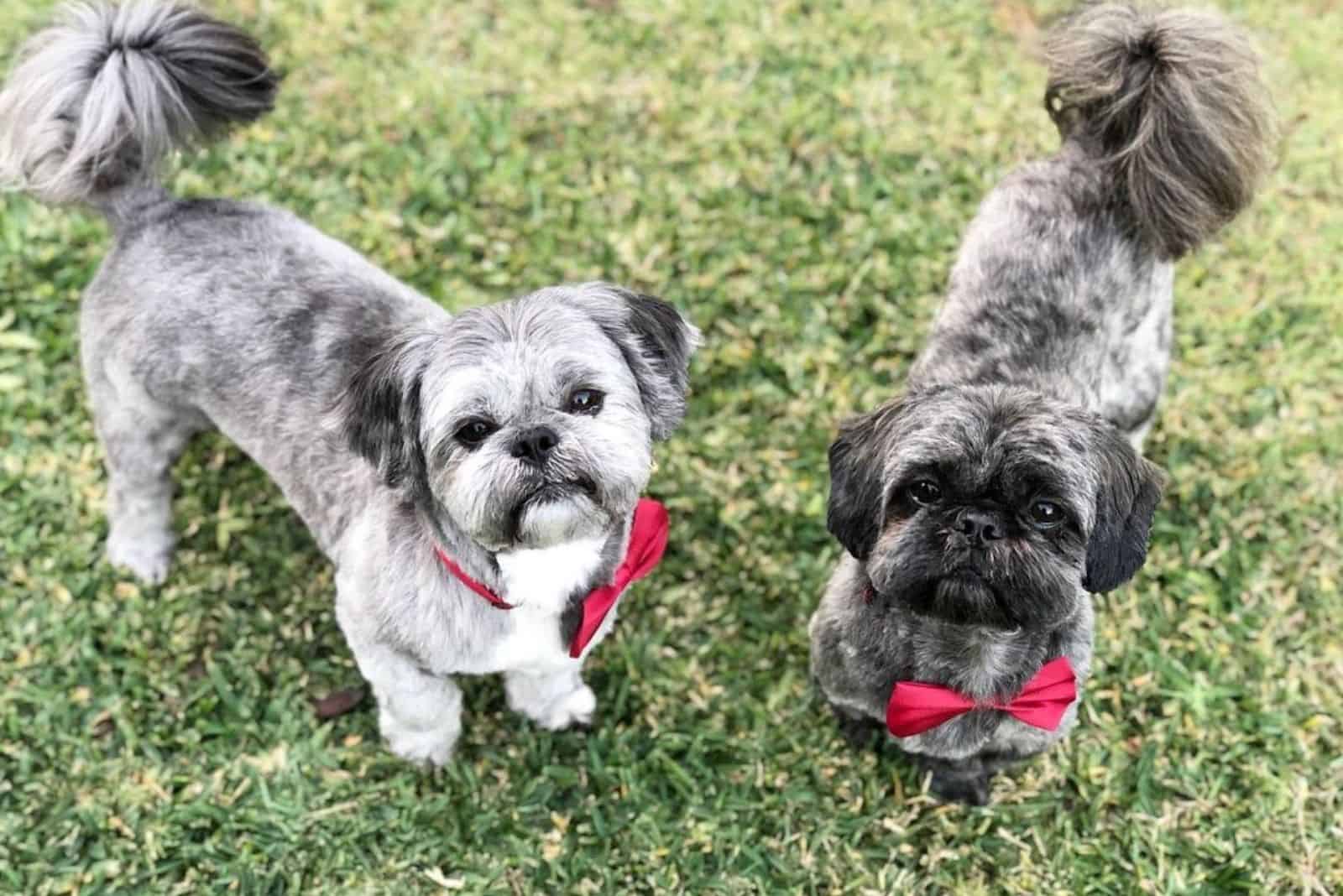You might have noticed, but small dogs are more popular than ever. Yes, people love them because they are really cute, but it goes beyond this. They fit easily into our homes and busy modern lifestyles, especially in urban environments and apartment living.
They take up less room than big dog breeds, their exercise requirements are easy to meet, and they don’t make much of a dent in your dog food budget!
Celebrities and influencers around the world have played their part in boosting the popularity of small dogs, such as mini Poodles, French Bulldogs, and Chihuahuas. They travel with them, grabbing photo ops whenever possible.
These pics are then plastered across magazines and social media, raising awareness of these pocket-sized pooches. And they’re almost always micro-dogs or little breeds such as the Shih Tzu dog. Can you imagine Lady Gaga trailing a Bernese Mountain Dog on a leash? Or Selina Gomez carrying a Great Dane? It might be fun to see, but it’s not going to happen…
So, small dogs rule, at least for the moment. And the Shih Tzu breed is still popular, often entering the top ten favorite dog breeds in many countries worldwide, even though they are probably the biggest of the toy breeds.
Perhaps you’re reading this because you’re thinking of getting one? You might be wondering which is the best color, or you’ve seen photos of brindle Shih Tzus and want to know more.
Either way, this is the place to be! We’re going to explore these wonderful little dogs and take a closer look at the brindle Shih Tzu in particular to give you all the information you need to make your decision.
We’ll begin with a question that most people ask…
What Is A Brindle Shih Tzu?
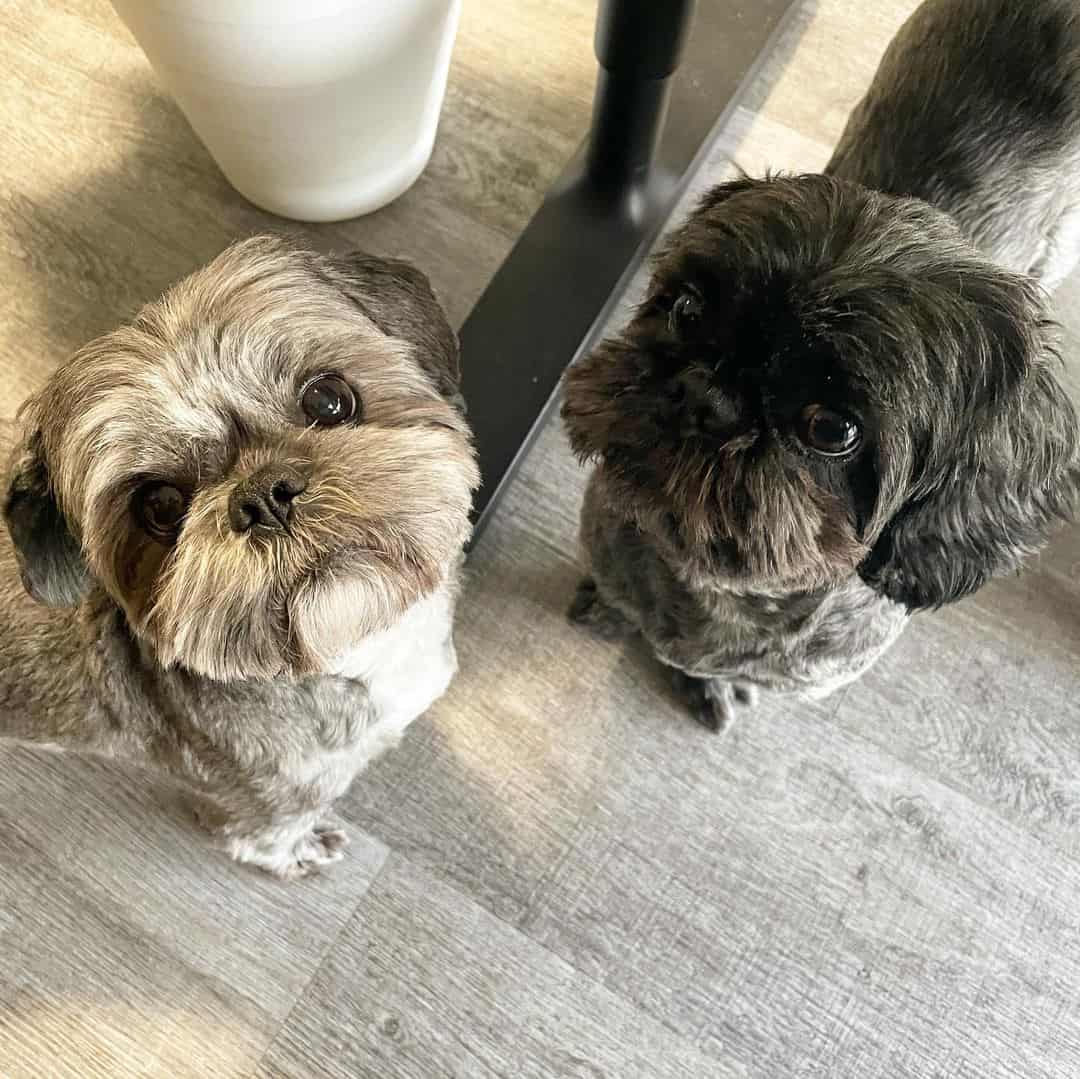
Photo from: @hello.teddy.ziggy
A brindle Shih Tzu is, literally speaking, a stripy dog!
The term brindle is usually listed with dog coat colors, which can be confusing as people tend to think that it is a particular color. In fact, brindle is a streaked pattern, and it can include different colors, including gray, white, gold, brown, cream, and black in any shade.
It is sometimes referred to as tiger striping because of the way the pattern appears across the dog’s coat, although it is usually much subtler than a tiger’s stripes!
Generally, the brindle pattern reveals itself as darker stripes over a light base color. On very rare occasions, you might find a ‘reverse brindle’ pattern with light stripes over a dark base.
Overall, the brindle pattern creates some unique and beautiful-looking dogs because of the wide range of colors and shades it uses. Some streaks will be wider than others, making for an even wider variation in patterns.
To be classed as a proper brindle Shih Tzu, it will have black skin points on the nose, paw pads, and eye rims. If they have a liver-colored or blue nose, then they aren’t true brindles!
For those interested in the science of dog breeding, the brindle pattern is caused by a recessive gene known as the K locus. The heaviness of the pattern is determined by the A locus gene (also known as the agouti gene). To make things more interesting, these sometimes interact with the B or D locus genes to affect the final coat color!
Although established and respected dog breeders have a wealth of knowledge and experience in their field, it’s a subject filled with uncertainty and a fair amount of luck and guesswork when it comes to producing pups of a particular color.
Are Brindle Shih Tzus Rare?
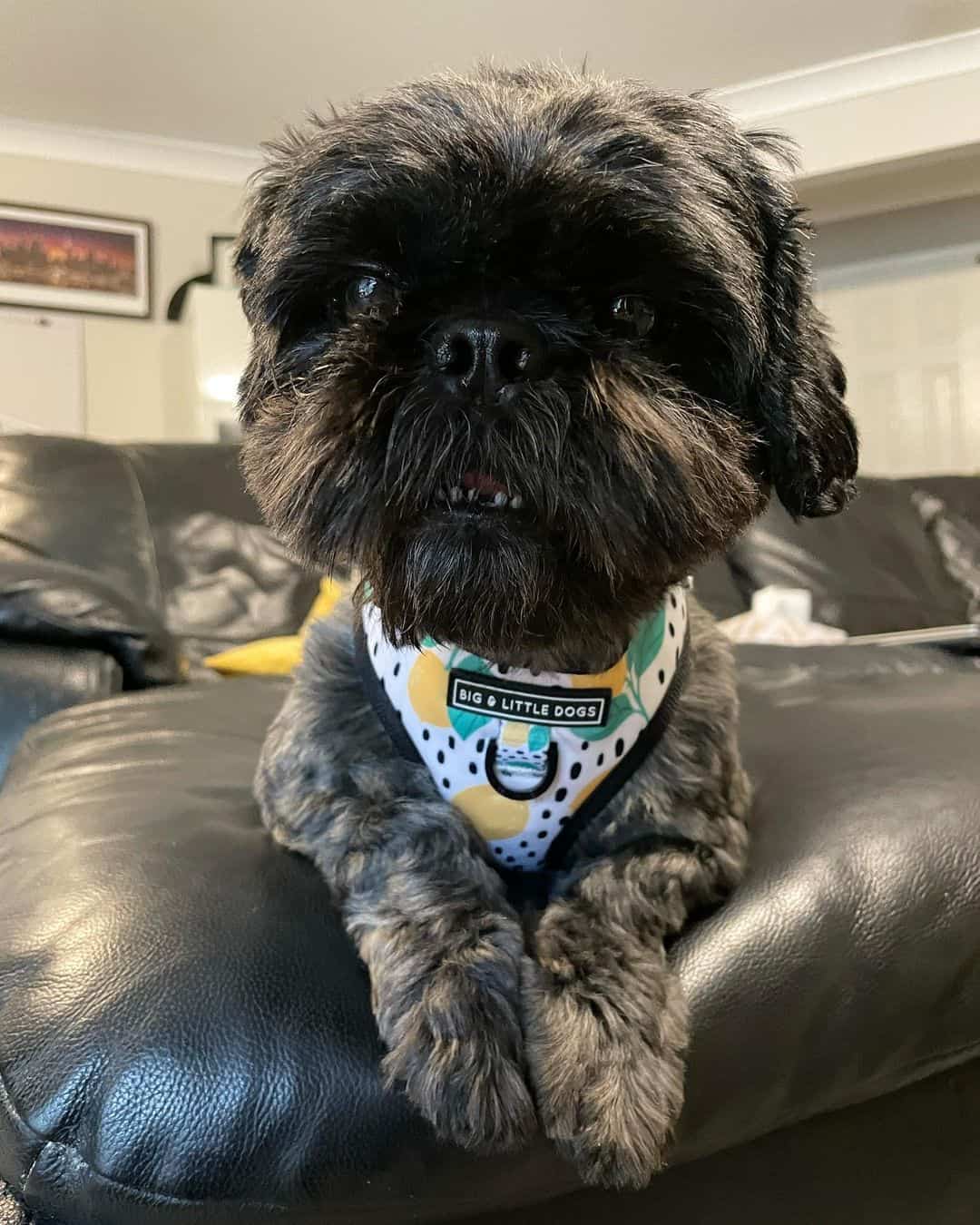
Photo from: @hello.teddy.ziggy
The brindle pattern itself is quite common, so brindle Shih Tzus aren’t rare, as such. However, certain colorations are less common than others, which is what makes brindle Shih Tzus so fascinating. You will never find any two brindle Shih Tzus with the same type of pattern and color.
You can find proof of this by Googling brindle Shih Tzu images, which will return thousands of results. Be warned, though, you might not get much else done that day, as you’ll be distracted by the cuteness!
What Is The Rarest Color Shih Tzu?
Believe it or not, the rarest color Shih Tzu is solid black. Now, most people would probably wonder how a black dog could be rare, but to qualify as a black Shih Tzu, the dog has to be completely black, with no other colors or markings present.
Many black Shih Tzus have white patches somewhere on their body. Even the tiniest streak of white means that this dog will be classed as a black and white Shih Tzu.
In addition, all Shih Tzu dogs that qualify as being solid black will also have a black nose, lips, paw pads, and eye rims. If these skin points are blue or liver-colored or the dog has white markings, then it isn’t a black Shih Tzu!
Because of these strict criteria, the solid black Shih Tzus is the rarest color.
Brindle Shih Tzu Colors
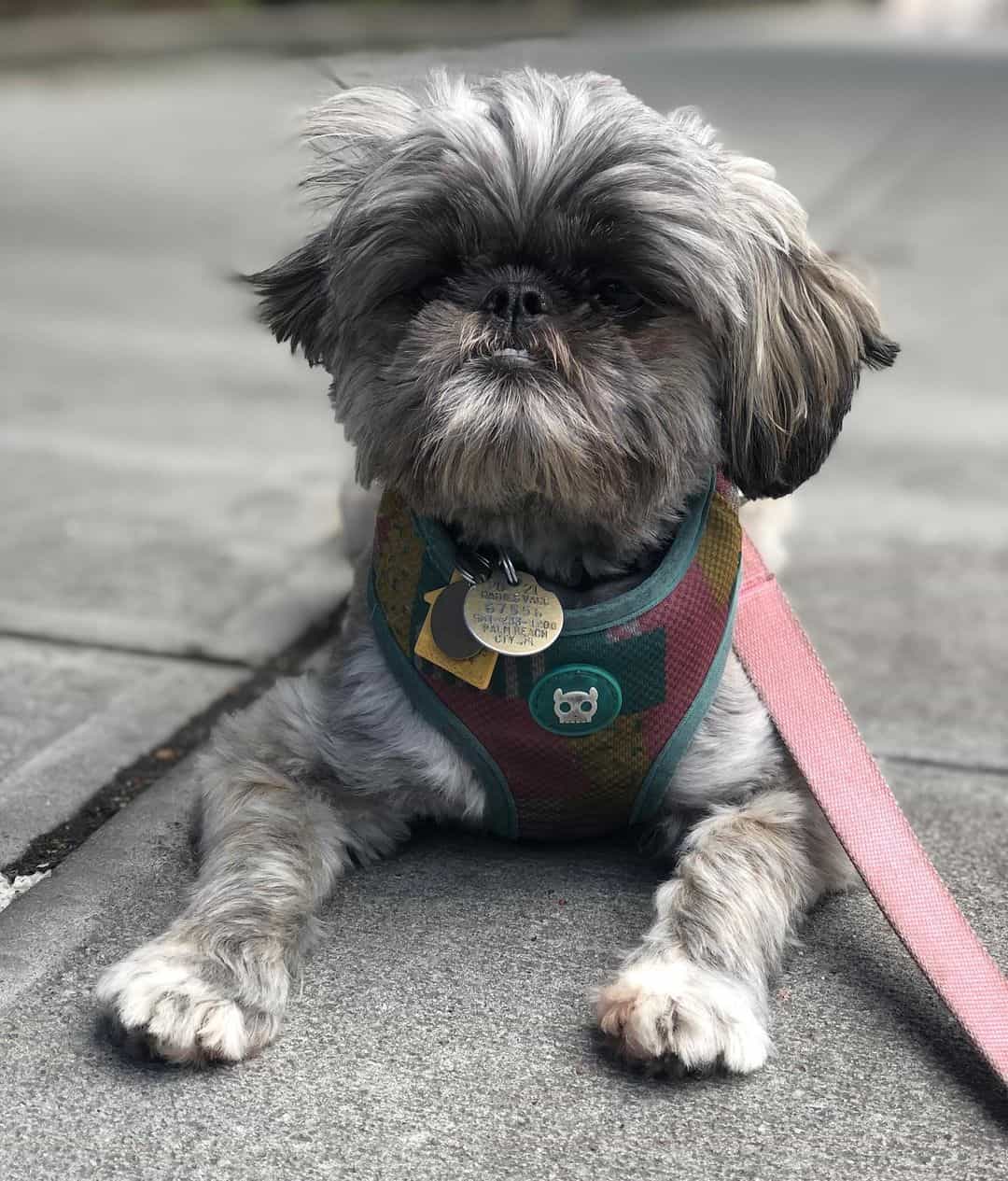
Photo from: @itscleopawtra
The AKC seems to have a soft spot for Shih Tzus, as their breed standards relating to colors and markings state that ‘All are permissible and to be considered equally.’
This is pretty unusual, as most dogs are restricted as to which colors are allowed, with anything outside of this being disqualified from the show ring or regarded as ‘serious flaws.’
The AKC lists the following colors as standard:
• Gold
• Blue
• Black
• Silver
• Red
• White
• Liver
• Brindle
They allow for solid colors as well as any combination of these common colors listed here, along with any type of markings, including the adorable tuxedo.
To make things more interesting, some light-colored dogs have black tips on their hairs, producing a shimmering effect from afar and giving the impression of a different color altogether.
As we know, brindle Shih Tzu refers to a pattern rather than a color, although it can include a mixture of these standard colors. This opens up an endless range of beautiful and fascinating color combinations, which is precisely why brindle Shih Tzus are the best dogs!
A Quick Word About Shih Tzu Coats And Care
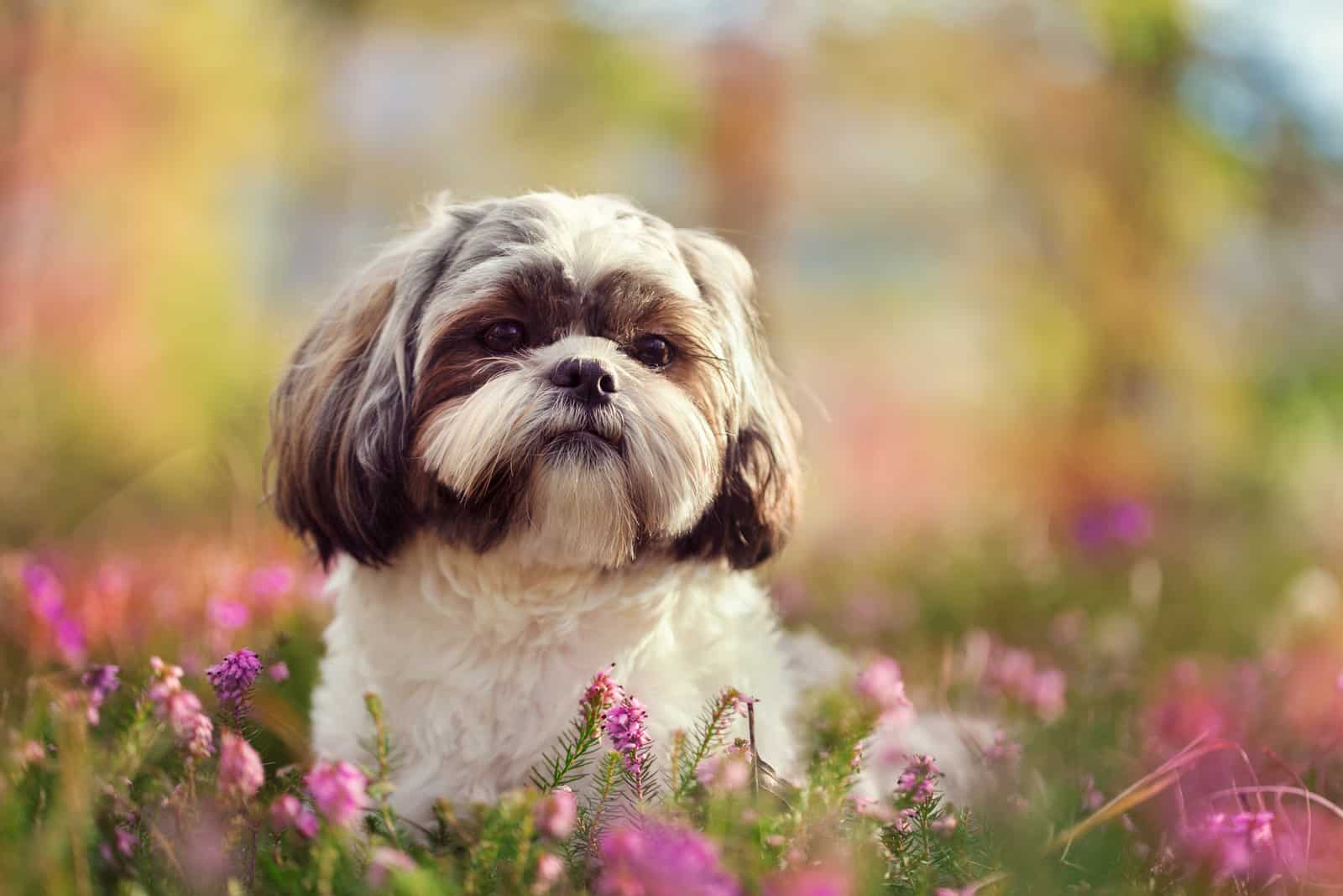
All Shih Tzus are naturally long-haired. They take a bit of effort to look after, but it’s totally worth it, especially if you plan on entering your beloved pooch in conformation shows.
However, many people choose to trim that long hair into a range of loveable and endearing styles, the most popular being the summer cut and the teddy bear cut.
This makes it more manageable, but it will still need regular grooming to keep it in good condition. Also, most dog experts recommend that you take your dog to a professional groomer at least once every six weeks. Now, this isn’t an option for anyone on a tight budget, so it’s understandable that it doesn’t always happen.
The main thing is that your dog gets the grooming it needs to stop any matting and tangling of the hair. When the fur becomes knotted and tangled, it pulls on the skin, causing your furry friend pain and discomfort.
It can also result in skin infections as air is unable to get through to cool it down. Dogs will often scratch at the area because it is uncomfortable, sometimes breaking the skin, allowing infections to start.
For this reason, you should brush your Shih Tzu every day if they have long hair and at least two or three times a week if they have short hair.
Grooming sessions should include checking and cleaning their ears, eyes, and teeth and clipping their toenails if necessary.
This isn’t just an exercise in making your dog look pretty. These are an essential part of your furry pal’s continued good health. Shih Tzus are prone to ear and eye infections, and dental problems can have a severely detrimental effect on their health. They can even be fatal if not diagnosed and treated in time.
Regular grooming is just part of being a responsible and loving dog owner.
Shih Tzu Brindle And White
This is an attractive color combination (but then, which ones aren’t?) that really turns heads when you’re walking your dog.
These pups have a mostly white coat with streaked patches of darker fur across the body. They’ll often have a black mask, meaning that the fur around the muzzle, eyes, and base of the ears is very dark, sometimes black.
Blue Brindle Shi Tzu
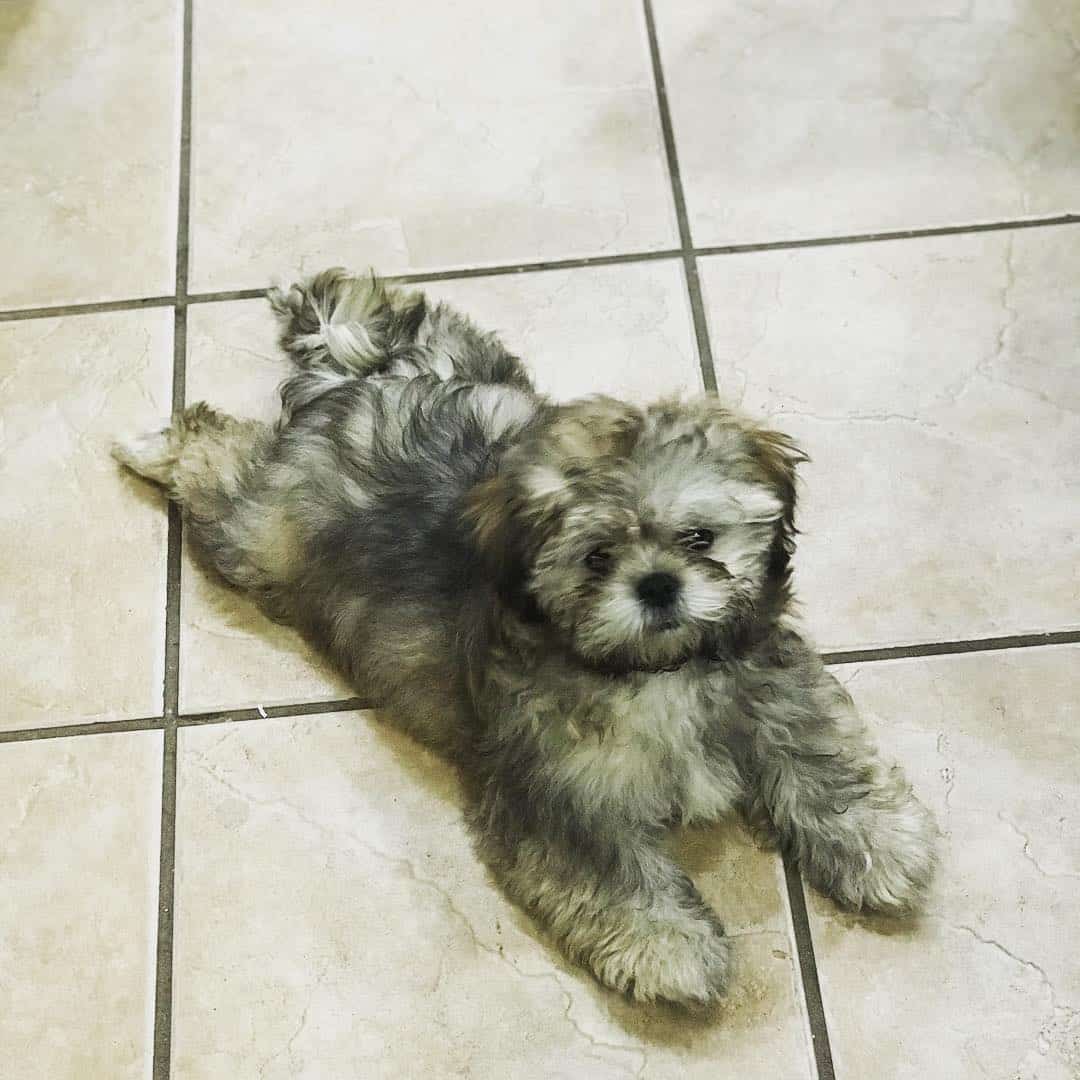
Photo from: @joon_the_shihtzu
When you see the word blue associated with dog colors, it’s easy to let your imagination run away. You might get the idea that a blue brindle Shih Tzu will resemble a striped, fluffy smurf.
And you’d be disappointed to discover that they don’t.
Blue, in terms of dog coat colors, is simply a dilution of the black coat, resulting in something like a charcoal color that has a bluish tinge when seen in natural light. A true blue Shih Tzu will earn the name based on its skin color rather than its fur. The nose, paw pads, lips, and eye rims (known as the points) will be blue rather than black like most other Shih Tzus.
Although it is regarded as a fairly rare color, it is, in fact, a whole range of different shades.
As we mentioned previously, although we used the term blue brindle Shih Tzu, it isn’t a true brindle as it has blue skin points.
Gold Brindle Shih Tzu
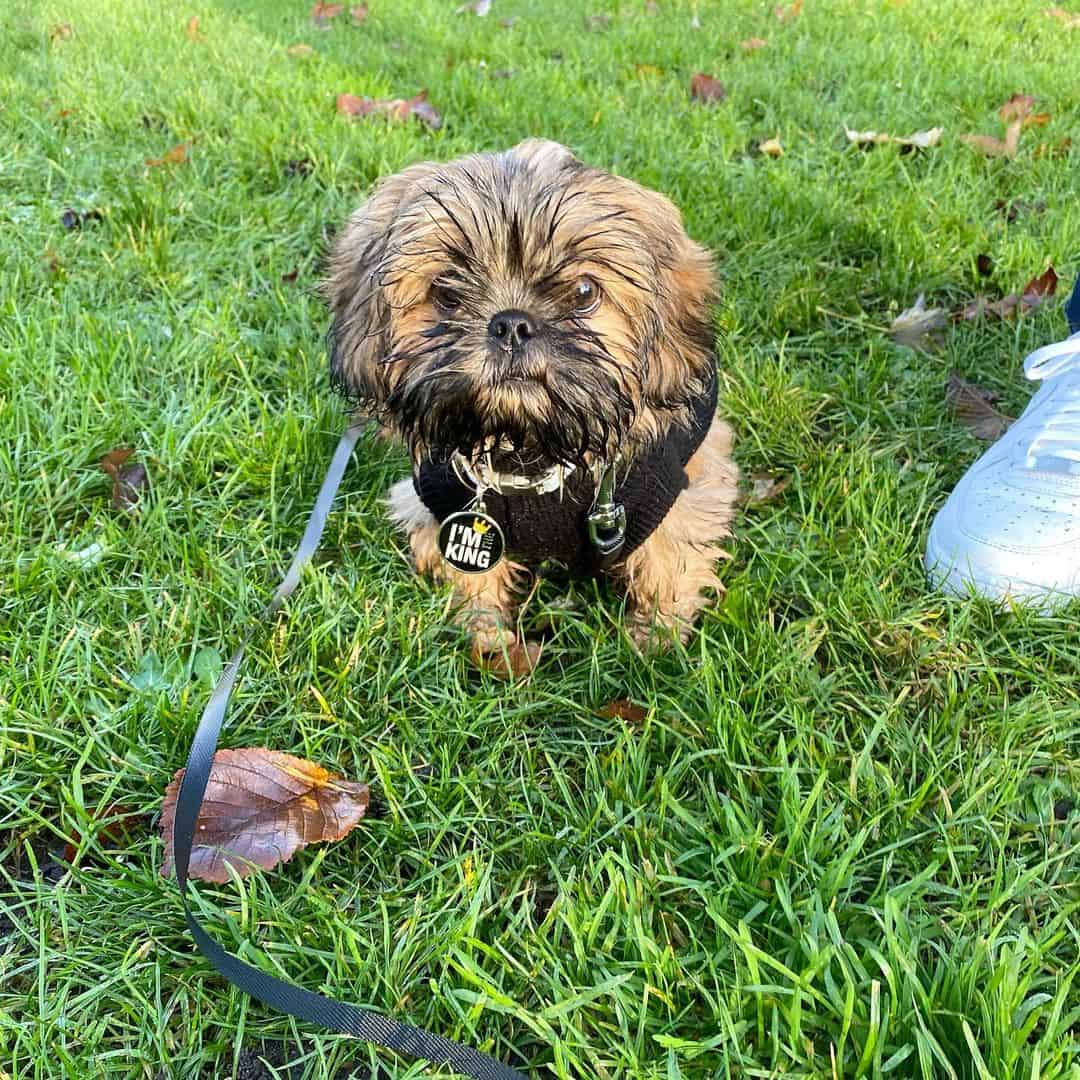
Photo from: @coopycoopycooper
You probably guessed that these dogs don’t actually look golden, as you’ve realized by now that dog color descriptions are a little bit over-the-top!
However, gold Shih Tzu pups are a vivid yellow-tan color for a while before settling to a soft yellow hue as the dog matures. Very few of them will have a solid gold-colored coat, and brindle black/gold coats are more likely.
Are Liver Colored Shih Tzus Rare?
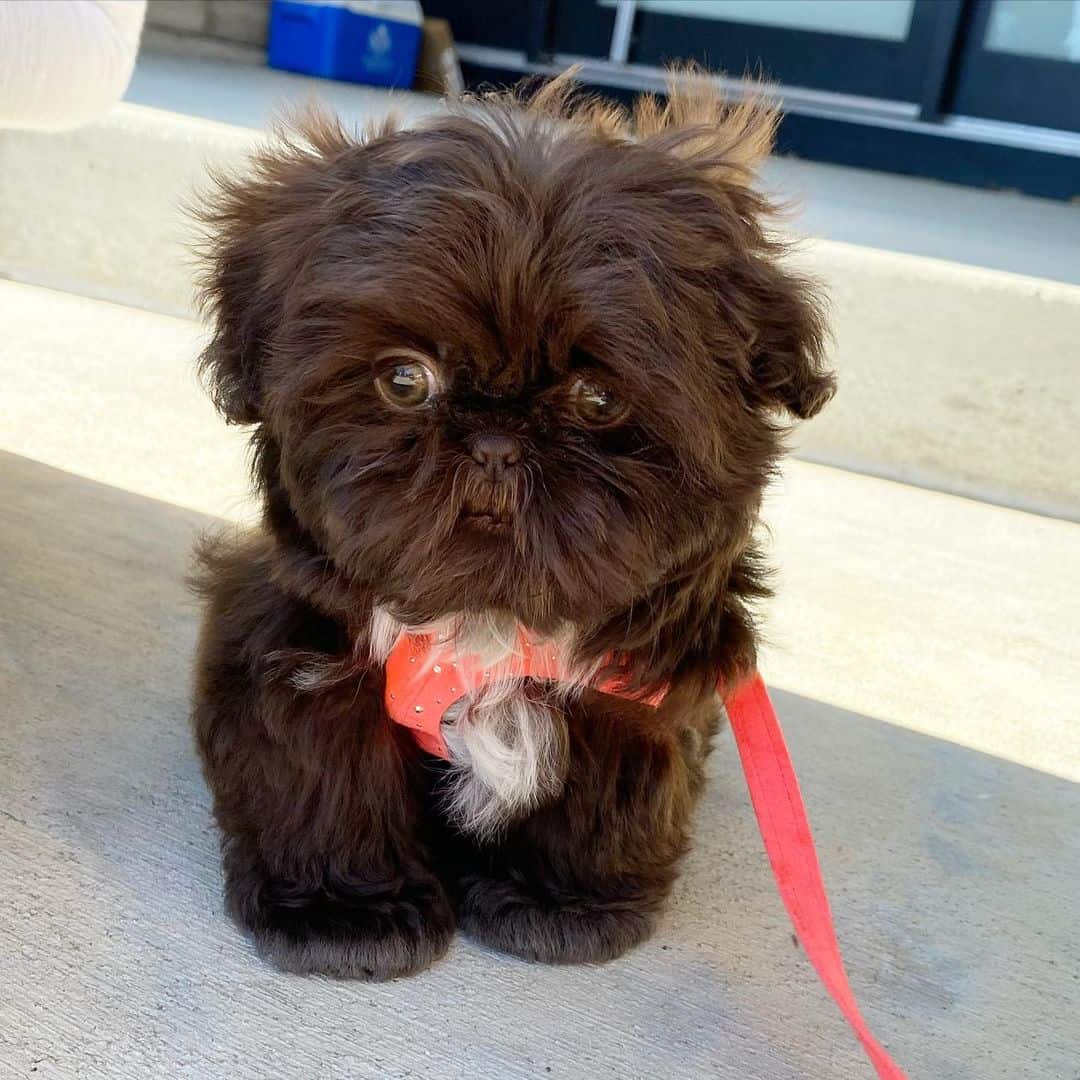
Photo from: @realrubytheshihtzu
Yes, and no!
Once again, this term doesn’t really describe the true color. In fact, liver is used to describe a wide range of colors, from a light, pinky brown to a deep, rich chocolate hue.
While most Shih Tzus have black skin points, the liver Shih Tzu’s nose, paw pads, and lips will match its fur. Liver and brindle Shih Tzus will also have these distinctive brown skin points. Again, they can’t be true brindles because of the liver-colored skin points!
Unlike other colors, the liver Shih Tzu is named because of the lack of black pigmentation in the skin points, rather than the color of its coat. It is the liver pigment that identifies the color of the dog.
Occasionally, dilution affects the coat to such an extent that it is referred to as lavender. This is not an official color, but it is exceptionally rare and very beautiful! These dogs will sometimes have lighter-colored or amber eyes rather than the piercing black eyes that this breed usually has.
Brindle Shih Tzu Color Change

Photo from: @doradadiva_shihtzu
“Will my puppy change color?”
It’s a question that many Shih Tzu owners (or those hoping to buy one) ask. More pertinently, people often ask, will my brindle Shih Tzu change color?
The quick answer to this is, yes, it probably will.
Shih Tzu puppies go through several color changes during their lives, mostly in the puppy stage. The American Kennel Club (AKC) allows breeders to change the registered color of any Shih Tzu pups up to three times.
We’ve seen how problematic it can be to predict dog coat colors, even for professional breeders. The fact that this breed changes color so much just adds to the fun!
When choosing a Shih Tzu puppy, it’s important to keep this in mind. If you head to a breeder’s kennels and pick out a pup based on its color at the time, there’s a good chance that you’ll be disappointed when you finally get it home.
Within the first year of its life, your beautiful bundle of fur will almost definitely change color. Darker shades will lighten, and light shades can sometimes become darker.
By the time it is 6 years old, it will probably be completely unrecognizable compared to the tiny furball you brought home! Brown brindle Shih Tzus often turn to a stunning gray with a white base coat. In others, the brindle pattern lightens so much that it is barely visible.
Is it natural? Yes! Does it bother you? Well, that’s for you to decide. Despite the color change, this will still be the same loveable pooch you chose. For many dog lovers, this color-changing super-power is what makes brindle Shih Tzus so special.
Brindle Shih Tzu Puppy
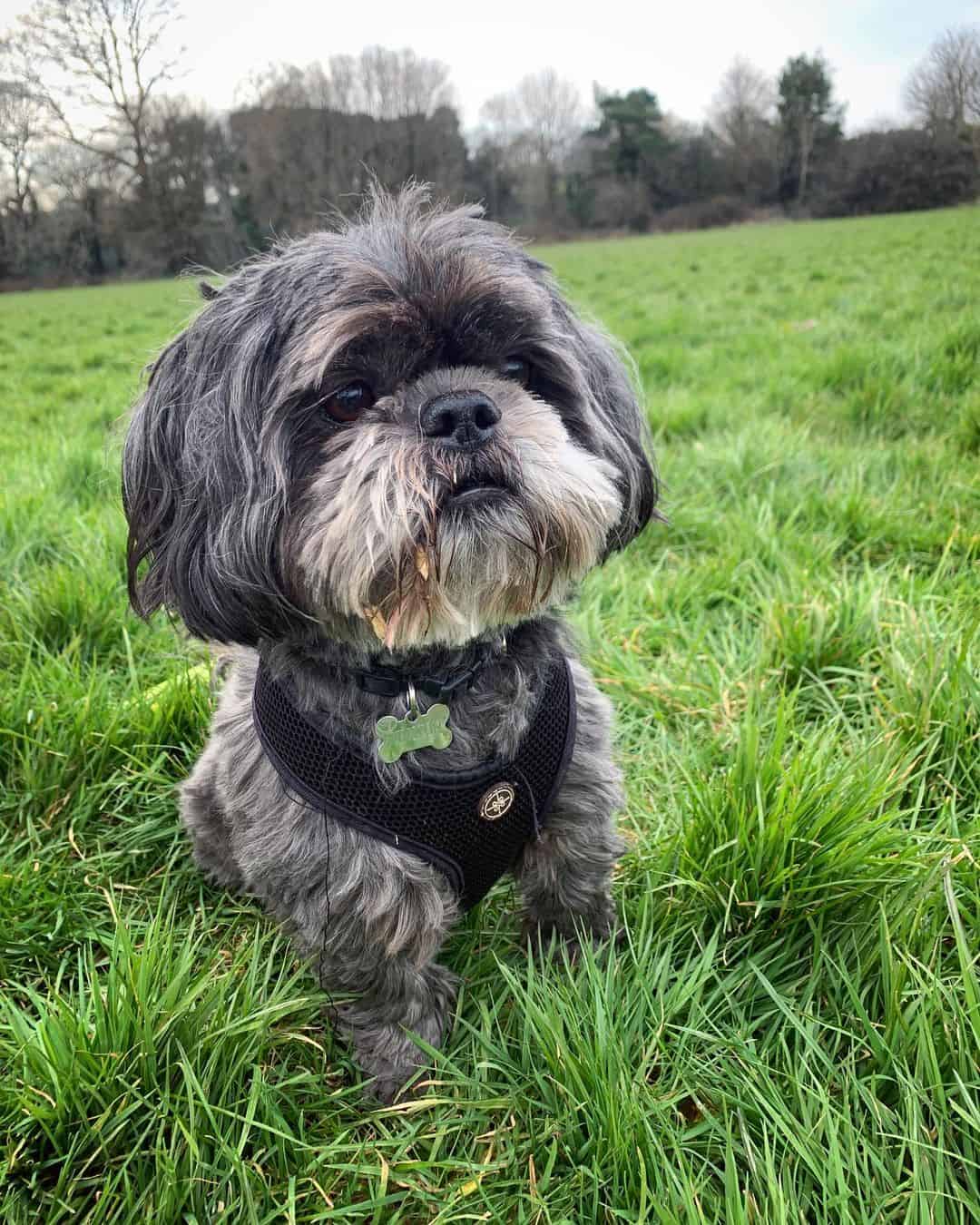
Photo from: @winstonthewonderpup
Before you head out to get your brindle Shih Tzu puppy, you need to prepare your home. These tiny pooches will demand your time, care, love, and attention, so you should make things as easy as possible for yourself by setting things up before they arrive.
Starting outside, if you have a garden or yard, you need to plug any gaps in the fence or make sure there are no holes in walls for your inquisitive pup to squeeze through. Do you have a pond or a pool? You’ll need to take precautions to ensure the puppy doesn’t fall in, at least until they learn to swim!
Inside your home, you should set aside three separate areas for your pup: one for sleeping, one for eating, and another for playing. This is important as it helps to set boundaries and will be useful when training your puppy.
The sleeping area should be in a quiet place, away from any bustle or noise. Ideally, you should invest in a dog crate and a few blankets, making the space as comfortable as possible. It won’t hurt to keep a few of their favorite chew toys here, especially during the teething stages, but it needs to be clear to them that this is not a play area.
Baby gates (or stair gates) can help to keep dogs out of places that are off-limits. You should also make sure that your trash can is out of reach or at least has a secure lid.
It’s also a good idea to inspect the areas where your dog is allowed to roam to make sure there are no trailing or exposed electric cables (cables can be covered with a chew-proof casing). You might want to remove breakable items such as shoes, purses, remote controls, beloved ornaments, and family heirlooms – basically, anything you don’t want to be ruined!
You’ll need to invest in equipment, such as:
• Food and water bowls (stainless steel is better than ceramic)
• A dog crate and/or bed
• Harness and leash
• Collar
• Brushes for grooming
• A dog toothbrush and toothpaste
• Puppy pads (or pee pads, for toilet training)
• Good quality branded dog shampoo and conditioner
• Poop bags (for being a responsible pet owner when out walking)
• A restraint for car journeys
• Lots of toys!
One of the most important things on your list is to contact a good local veterinarian. You need a vet you can trust with your dog’s health for the next decade or so.
Once all these issues are sorted out, you’re good to go.
Brindle Shih Tzu Price
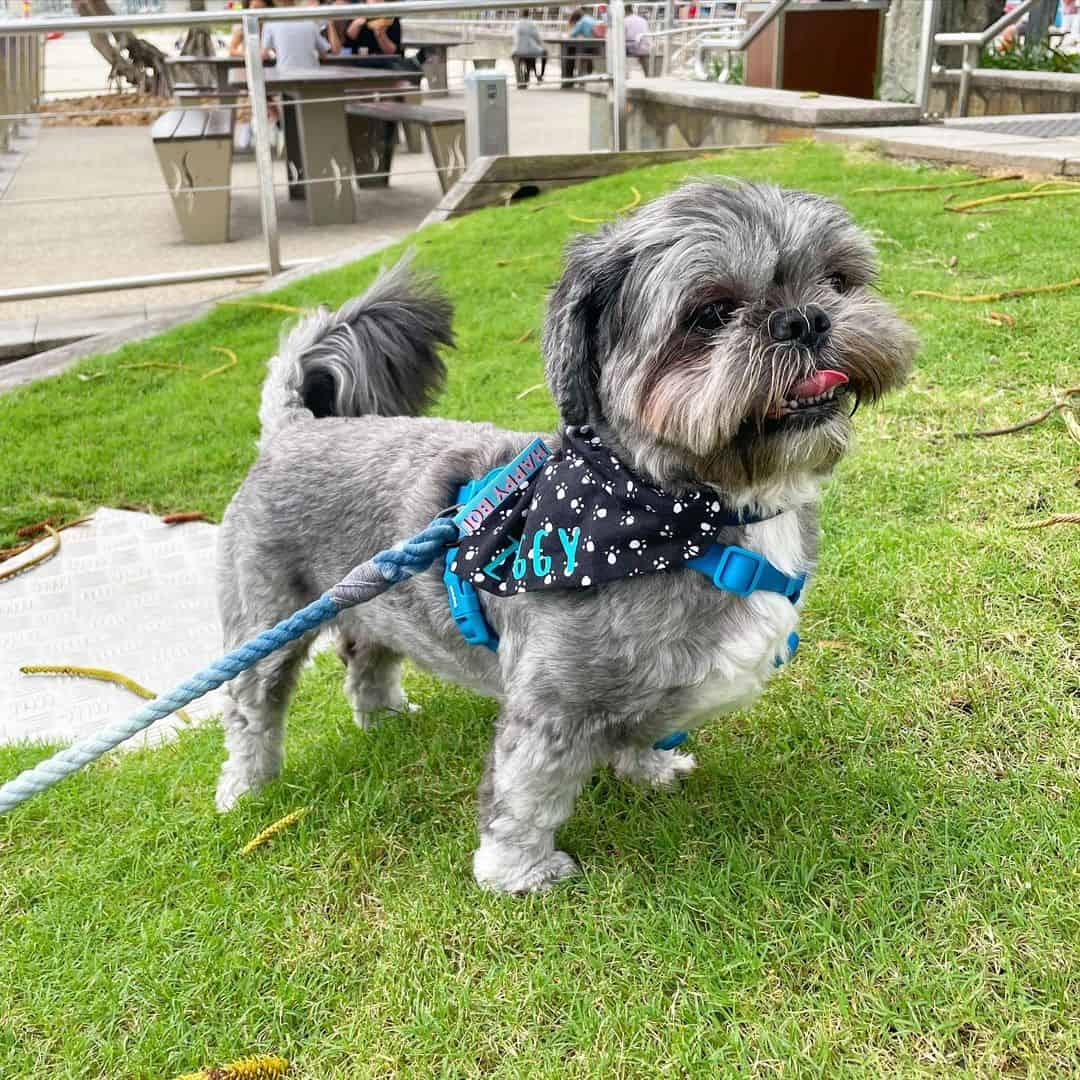
Photo from: @hello.teddy.ziggy
Buying any dog is a big thing. Understandably, you want to pay a fair price, and you want to avoid being ripped off by unscrupulous people. You want a healthy dog, but you don’t want to pay far more than it is worth.
So, what should you expect to pay for a brindle Shih Tzu?
The average price for a Shih Tzu in the USA is $2,300, but you could pay as little as $750 or as much as $3,000–4,000. For many people, this is a serious amount of money to pay for any dog, let alone one so small! We’ll look at the possible reasons for these prices a little later.
One of the biggest factors affecting the price range is your location in the USA. Prices tend to be much lower in the southern states, generally because many more dog breeders are based there. The further north you head, the higher those prices will climb. Once you get to, say, the New England area, you can expect the price to have doubled.
At the time of writing this article, when the entire world is coming to terms with the effects of the Covid-19 pandemic, it has to be said that some people are using the circumstances to maximize their profits. During the various lockdowns, especially across the USA, the UK, and parts of Europe, demand for pets (and dogs, in particular) began to soar.
Some breeders saw this as an opportunity to make some extra cash. In many cases, puppy prices doubled or tripled.
Hopefully, as we come to grips with the pandemic and things start to settle down, puppy prices will return to normal, but there are no guarantees. All we can do is hope for the best and always seek out the more respected and reputable breeders who will be more likely to operate honestly and fairly.
Now, we’ll talk a bit more about those breeders and why they charge so much!
Brindle Shih Tzu Breeders
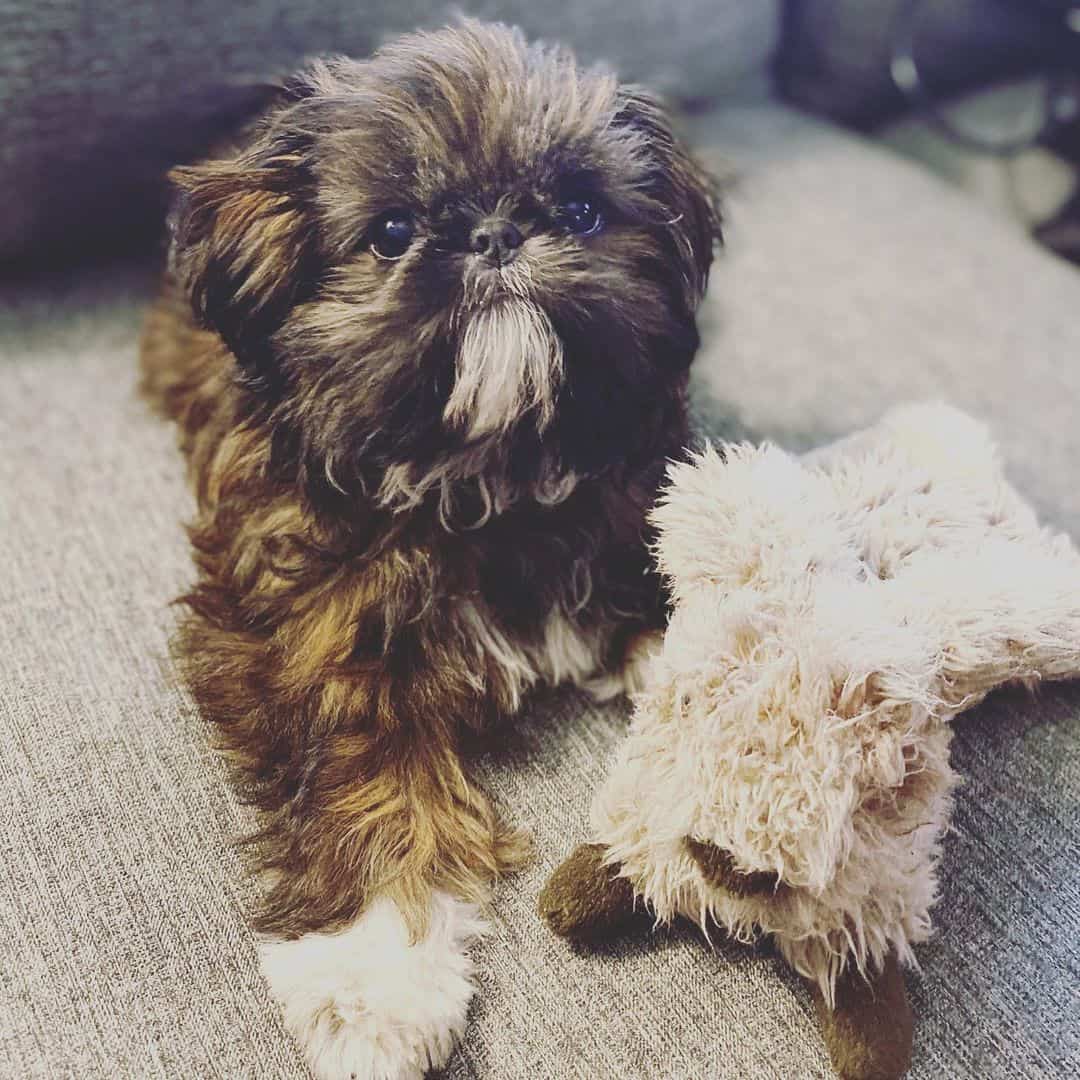
Photo from: @buster.pupper
Let’s look at the facts to get some perspective. A reputable breeder invests time and money into preserving the breed. It’s not just a job; it’s their life. They eat, sleep, and breathe dog breeding.
This means that they frequently make a loss on each litter, as they absorb most of the costs involved. They ensure that their dogs are accommodated well and fed the best food. They spend thousands of dollars on testing for certain diseases and medical conditions.
All of this has to be recovered somehow, which is why puppies can cost so much.
Of course, you can find brindle Shih Tzus for much less, but this should set alarm bells ringing. If a dog is advertised for well below average, you should question why this is. There’s a good chance that you’ll end up with an unhealthy puppy that will cost you an arm and a leg in vet fees.
There’s no better way to get a feel for a breeder than by visiting them in person. The state of the place will give you an idea of how well it is run, and the very fact that they are happy to let you snoop around is a sure sign that they have nothing to hide!
Good breeders welcome questions and are happy to discuss things with you. Anyone looking to make a fast buck will want you to hand over the cash and take the pup before you change your mind.
Brindle Imperial Shih Tzu
Shih Tzus are small and cute, right? But do you know what’s even smaller and cuter? Imperial Shih Tzus!
What is an Imperial Shih Tzu? you might ask.
Sadly, it’s not much more than a marketing ploy to increase the price. As Shih Tzus are small anyway, they are classed as a toy breed. Dogs that fall below the average size are sometimes labeled as imperial, suggesting that they are a separate or rare breed.
To qualify as imperial, they need to weigh between 4 and 9 pounds and measure less than 9 inches. They are super-cute, but they often come with additional health complications and are prone to sickness and injury.
How To Buy A Brindle Shih Tzu
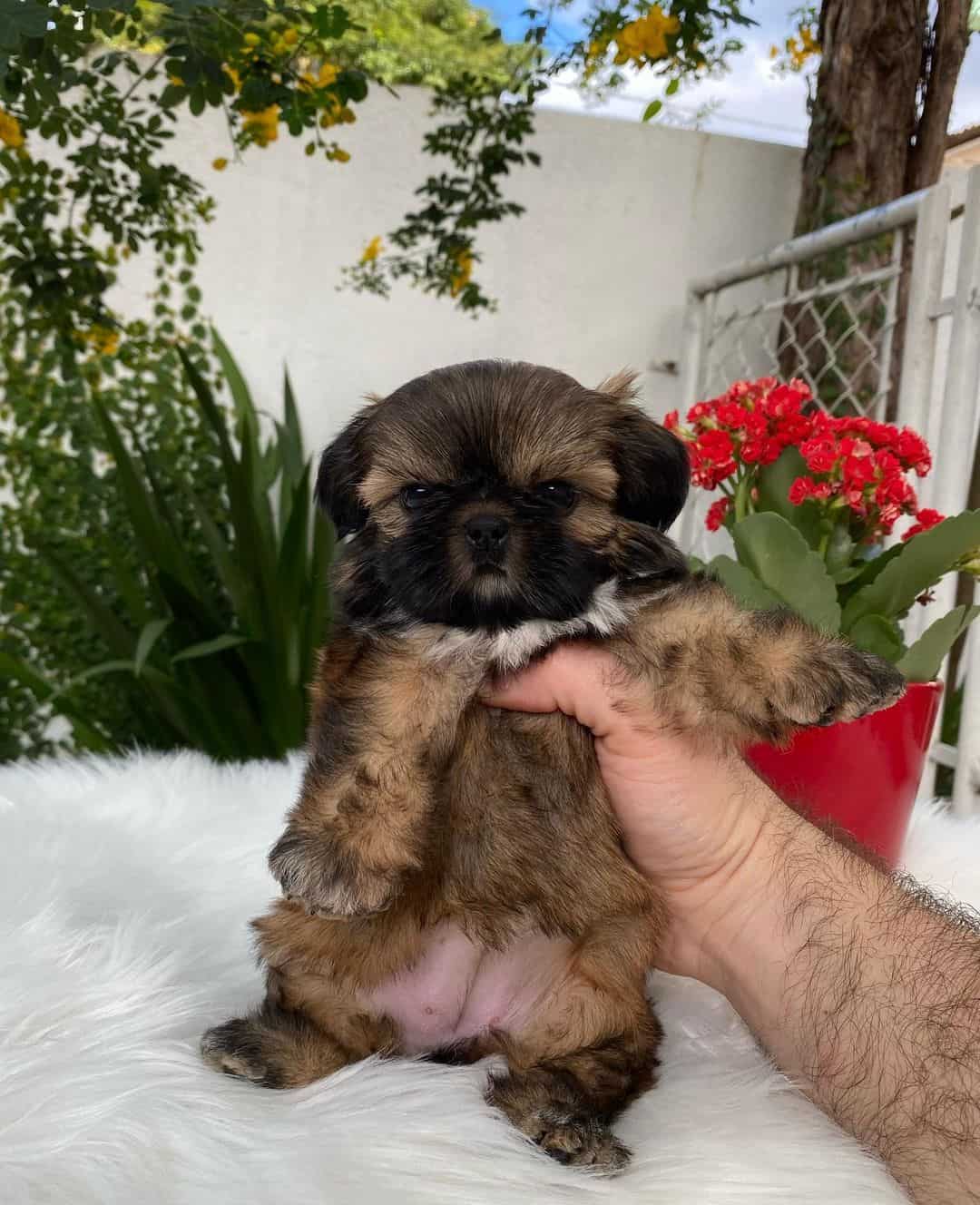
Photo from: @canilbrpeppers
Nobody could blame you for wanting one of these adorable creatures. If you’ve seen a brindle Shih Tzu online, on TV, or better yet, met one in person, you might have fallen in love.
So, what do you do about it?
The first thing is to be sure that this is what you want. It isn’t just a question of finding the right dog for you. You must also be certain that you are the right kind of person for the dog!
Can you afford it? Not only the initial cost, which could be as much as $4,000 but are you financially prepared for all the extra cost of raising and caring for a puppy? This is a commitment that could last as long as 16, maybe 18 years. You need to provide food, toys, collars, leashes, beds, treats, etc. And that’s before we mention grooming and medical costs.
Let’s say you’ve got that aspect covered and are happy to proceed. You now need to find a Shih Tzu breeder or visit a rescue center or shelter. Obviously, the latter will be far cheaper, possibly somewhere between $400 and $600, but the likelihood of finding a brindle Shih Tzu puppy in one is remote.
We talked about the need to use a reputable breeder earlier, but this is an essential point to bear in mind. Avoid pet stores, puppy mills, and backyard breeders as they have a reputation for maximizing profits over welfare.
Aside from this, you risk buying an unhealthy pup that will cost you thousands of dollars in vet bills and may not live very long.
The final price you pay for your brindle Shih Tzu will depend on the breeder as well as your location. Of course, the demand for a particular breed or color will have a bearing as well.
In Conclusion
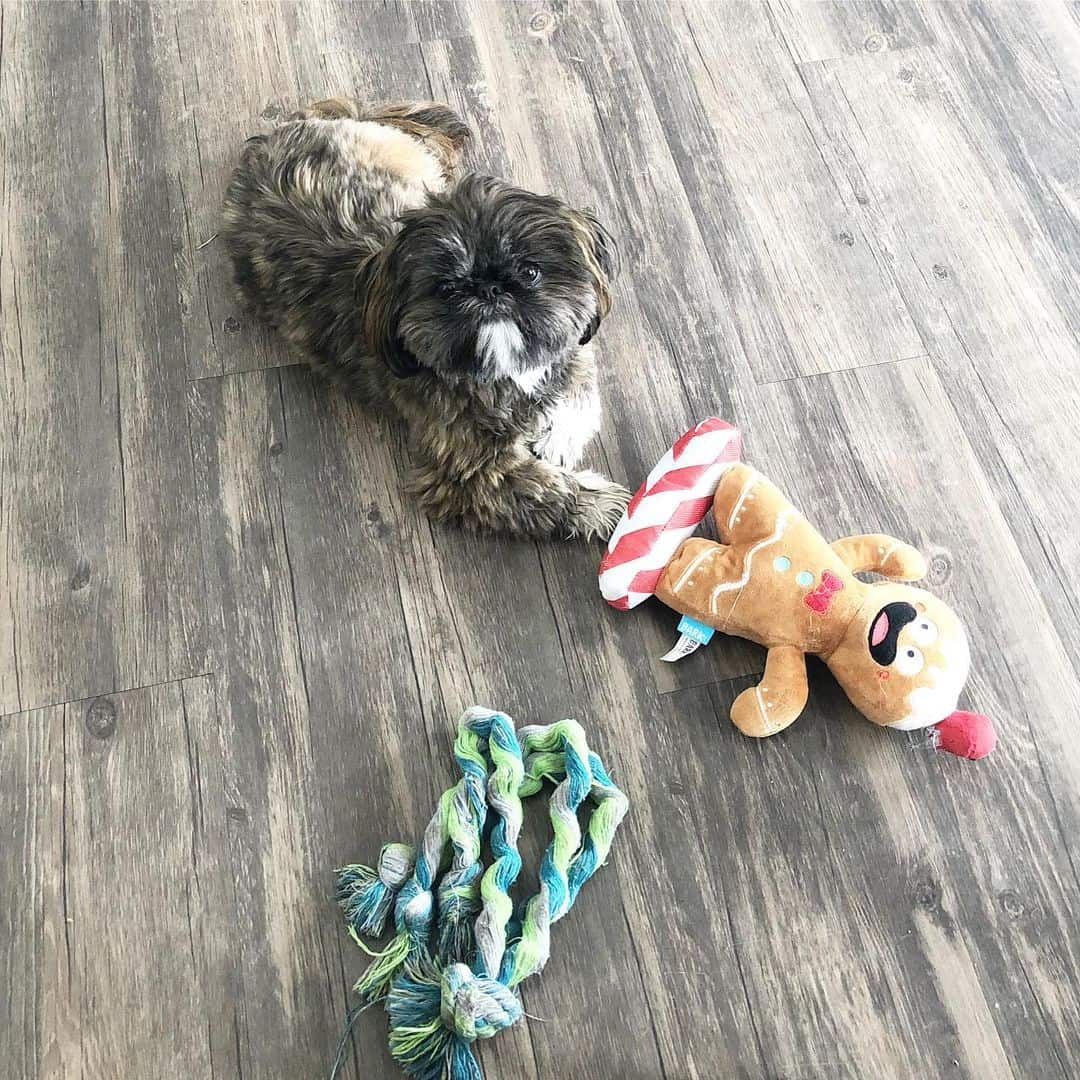
Photo from: @buster.pupper
Buying a dog is a long-term investment and is never something to be taken lightly, as this is a living creature with needs and feelings of its own. But you already knew that because you’re a decent human being and will make a wonderful dog owner!
You’ll understand that choosing the right dog can take time. You also know that for this relationship to work, you have to be a good match for your dog, just as much as they need to fit in with your routines and lifestyle.
You’ve got your heart set on a brindle Shih Tzu, and that’s great, as these are amazing dogs. Hopefully, you’ve found some of the information here useful in your quest.
To help you get the most out of this article, we’ll go over some key points again:
• Prepare your home well before your puppy arrives – purchase the equipment so it is all ready and in place so that your pooch can settle in with minimal fuss. Puppy-proof your home as far as reasonably possible.
Most importantly, have a quiet place set aside so they can decompress at their own speed. This will be a gigantic change for them, and they’ll need all your love and care to guide them.
• Use a respected, established, reputable breeder – this is the best way to ensure you get a healthy pup of good quality. Buying cheaply from pet stores or private ads online rarely ends well. Sometimes, the pups don’t even exist!
Even worse, the pups are real but are sickly and have been kept in appalling conditions. A good breeder will perform health checks and provide documentation as well as health guarantees.
Bear in mind that few breeders can produce a particular color of dog to order, and you may need to wait for a few months before you get your beloved brindle Shih Tzu. By all means, try a local rescue center or dog shelter, but be realistic about your chances of finding exactly what you’re looking for.
• Commit to a regular care and grooming regime – brush their fur daily if long, or a couple of times a week if the hair is cropped. Check their teeth, eyes, and ears regularly and get them checked at the vet twice a year. Don’t forget to clip those toenails!
Ideally, it’s best to take off a tiny amount every week rather than wait until they get too long and need a lot taking off. Use a specially-made tool rather than scissors or clippers not designed for the job, or you may hurt them and damage the nail. If this isn’t something you are comfortable doing, then you can always hire a professional groomer to do the job for you.
Finally, remember that your pup will change color as he matures. This doesn’t mean that he’ll be any less cute or that his character won’t shine through. Just enjoy the love he gives and the antics he gets up to. Look after him well, and he’ll be a loyal, loving companion for a good 15 years or so.
And that’s something worth cherishing, whatever his color!
